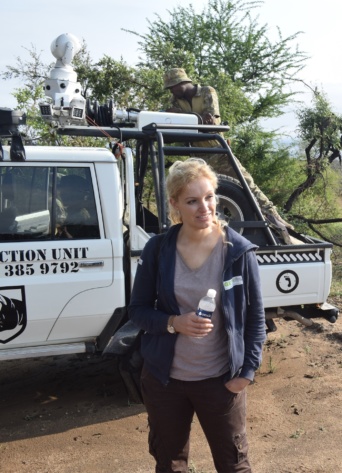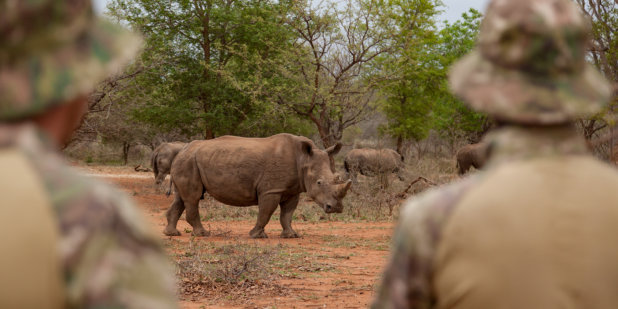- About
- Topics
- Picks
- Audio
- Story
- In-Depth
- Opinion
- News
- Donate
- Signup for our newsletterOur Editors' Best Picks.Send
Read, Debate: Engage.
In Thorny Bush, to be specific. Ralph Koczwara recalls: "It was my first time on a photo safari in the Greater Kruger Park in South Africa. And in Thorny Bush, one of the private concessions attached to the official Kruger National Park, I met this ranger." Koczwara asked him what problems they're facing here in the Greater Kruger - and he was surprised, not to get one of the usual optimistic phrases to satisfy tourists.
"The man burst into tears, he said they're are slaughtering their remaining rhino right in front of their eyes, and there's nothing they can do about it."
An answer that kept bubbling in Koczwara's head all the way home. Back in Germany, he founded "Hemmersbach Rhino Force", a non-profit organisation which he called after his successful IT-company he established almost 20 years ago. From then on, the entrepreneur turns into a direct action philanthropist, taking up the fight for the survival of rhinos.
Video interview with Ralph Kozcwara; Courtesy Hemmersbach Rhino Force
That was back in spring 2016. At that time people in South Africa called him the 'Crazy German', maybe because they could not yet make sense of his determination. Today, Hemmersbach Rhino Force – briefly Rhino Force – patrols along the borders of the Greater Kruger, using 4-WD vehicles, one of them having a 360° Multi-Sensor-Surveillance System on board. The troop is a military-trained special unit, they carry semi-automatic weapons and bulletproof vests. Recently, Koczwara equipped them with the latest night vision goggles from a Spanish defense company – goggles, that are so advanced that they had to obtain special export licenses from Spanish and German governments respectively. And all that technology, especially those night vision goggles, it is hoped, could eventually change the game on the ground at Kruger Park.
Koczwara collaborates with 'Protrack', located in Hoedspruit, Limpopo province, a large private security provider around Kruger Park, from which he recruits a majority of his Rangers for Rhino-Force where they eventually go through a rigid training program.
"Once people recognize the benefit of RHINO FORCE we can make it succesful in all of South Africa."
Vince Barkas, Founder of ProTrack Wildlife Protection, about the collaboration and role of RHINO FORCE in South Africa
"We also work closely with the National Intervention Unit, a South African special police unit", Koczwara explains. "And more and more owners of private concessions are asking to cooperate with us." That's because the successes of Rhino Force don't go unnoticed.
33 Poachers have been caught in the first quarter of 2018 alone. And how many rhinos are still alive due to the sheer presence of the troupe alone one can only guess. The poachers recognise our patrols”, he claims, “to see our 4-wheel-drives showing up on the streets scares them away – Hemmersbach Rhino Force is and needs to be a Direct Action Organisation“, Koczwara explains.
„We step in and take action whenever action is required to accomplish our mission, and that is: to save rhino for future generations. We are a 100% self-funded organisation, we don't need to wait and check back with donors.“
A great advantage in a deadly game which requires continuous attention and action in order to protect the living rhino, as well as constant adaption to changing circumstances in a battle against organised crime, corruption and extreme poverty.
But why does it take someone from as far away as Germany to step in and take profound action, when there are so many very rich people around Greater Kruger that can afford private luxury safari lodges? „That's a question I keep asking myself over and over again“, he says. „And I still haven't found a satisfying answer.“
The 41-year-old native of Nuremberg, an ancient city in Bavaria, founded his company in 2000, which offers Global IT-Services for many well-known high tech and computer hardware companies. Today, Hemmersbach runs offices in 35 countries and has an annual turnover of approximately 200 million Euro. Koczwara doesn't lack financial resources to take up the fight against the poachers. Nor does he lack determination either. A life-task, that's what his commitment to saving rhino has become, he says.
But is it a fight that can be won anyway, as long as demand, especially in Southeast Asia, drives up rhino horn prices to such outrageous heights that even surpass gold or cocaine? Koczwara surely is determined, but he is also a realist.
"It may be that we can not stop poaching in South Africa. But at least we'll gain some time to implement other effective measures."
And since time is key for the rhinos to survive, Koczwara is pursuing an additional plan – in neighboring Zimbabwe. Starting in January 2018, he has leased a 75,000-hectare site, and he is still negotiating another 150,000-hectare park. A purchase is not possible because the area falls under the National Park Act.
The terrain, beautifully located at the shallow banks of the Lower Zambezi River, the border river to Zambia between the Lake Kariba and the world-famous Mana Pools National Park, once was home to Black Rhinos. And it might not take too long for the first rhino to run through the Zambezi Valley again.
"The poachers will come to the Zambezi as soon as the rhinos are back, there's no doubt about that," says Kurth Slight, a former Marine, who trained Rhino Force Zimbabwe's rangers and built the base camp with them. "But we will be prepared."
The Rhino Force Rangers in Zimbabwe also undergo a rigorous military training, although they are here, unlike in South Africa, provided by the Zimbabwean National Park Authority. To meet the specific requirements of anti-poaching rangers, they now work with probably the most famous anti-poaching game ranger in southern Africa, Pete Clemence. He took part in the campaign to evacuate the last Black Rhinos from Zambezi Valley over 30 years ago and to transfer them inland for the sake of their safety. Clemence, now in control of Rhino Force's Zimbabwe operations says:
"Bringing back the rhino here after all these years is a dream come true."
We met Pete Clemence at a Rhino Force's base in Zimbabwe and talked about his experience as a tracker, anti-poaching ranger, conservationist and his love for wild animals. Listen to his story of how he found a poached mother rhino and the heartbreaking fate of her orphan baby rhino.
Famous conservationist, ranger and tracker Pete Clemence tells the story of a poached mother rhino and her baby
Pete Clemence saves a baby orphan rhino after his mother was poached. Video and voice over: Bryce Clemence
But even in the event of the worst-case scenario, i.e. if they failed to protect the rhino population in South Africa and Zimbabwe from poaching, Koczwara would like to have one last ace up his sleeve: a biobank.
 Therefore he asked the renowned veterinarian and expert on assisted fertilization of large mammals Dr. Imke Lüders from Hamburg to join his team and to lead project "Cryovault". A minimum basis of genetic variety is important to breed and grow a viable population of rhino, Lüders points out.
Therefore he asked the renowned veterinarian and expert on assisted fertilization of large mammals Dr. Imke Lüders from Hamburg to join his team and to lead project "Cryovault". A minimum basis of genetic variety is important to breed and grow a viable population of rhino, Lüders points out.
His role model, Koczwara says, is South African gamekeeper and environmentalist Dr. Ian Player, who saved the species from extinction in the past century with his famous "Operation Rhino". At that time, the stocks were even more decimated than today, but Player showed that the fight is not yet lost even when the numbers are so low.
"With Rhino Force, our strategy is based on three pillars," Koczwara explains.
"First, the fight against poaching in the Greater Kruger in South Africa. Second, the resettlement of Black Rhinos in Lower Zambezi Valley in Zimbabwe. And third, the Cryovault as a last resort."
As for today, Hemmersbach Rhino Force is already operating on multiple levels. Besides these three pillars, Rhino Force focusses on the strategy to shift tourism, one of the most important sources of income for many people in the region, away from hunting and towards eco-friendly tourism activities, like for example photo safari - or the ambitious idea of developing a sort of educative tourism for people and families who would like to learn and to experience how conservation can work from first hand. The difficult part of this is to find a sustainable model that involves local communities and ensures their participation and commercial benefit so that they can make a living from the living animals, not the dead ones.
As Carl van der Riet, a former hunter from a family tradition full of hunting and now working with Rhino Force, puts it:
„We realised that hunting is not sustainable, even here at the Lower Zambezi Valley, where wildlife appears to be so abundant. But that can change quickly.“
Koczwara is fully aware that neighboring communities need to be involved in all of those processes if they want to be successful in the long run. To getting people, especially youngsters, in touch with their heritage, in touch with nature again, is the first step and key to see the true value of a sustainable environment – an environment that is in balance with all creatures great and small involving with their communities.
Following the motto 'big ideas start with a small step', Rhino Force has begun to involve local schools like the one here in Chirundu where its pupils engage to clean up the environment. The Chirundu school is situated nearby the main road where trucks are passing on their way to the Sambian border. Truck drivers throw off the leftovers of their food with the plastic packaging. Elephants crossing the road towards the reserves are eating these leftovers and get harmed by the plastic. By cleaning up the environment school children learn to engage with wildlife and that they can make a change.
A truly ambitious undertaking, which FP will follow and document throughout the following episodes to come.
Photos: Frank Odenthal, Murat Suner / Videos: Murat Suner, Bryce Clemence

